vin DACIA DUSTER 2012 1.G Owner's Manual
[x] Cancel search | Manufacturer: DACIA, Model Year: 2012, Model line: DUSTER, Model: DACIA DUSTER 2012 1.GPages: 200, PDF Size: 2.4 MB
Page 57 of 200
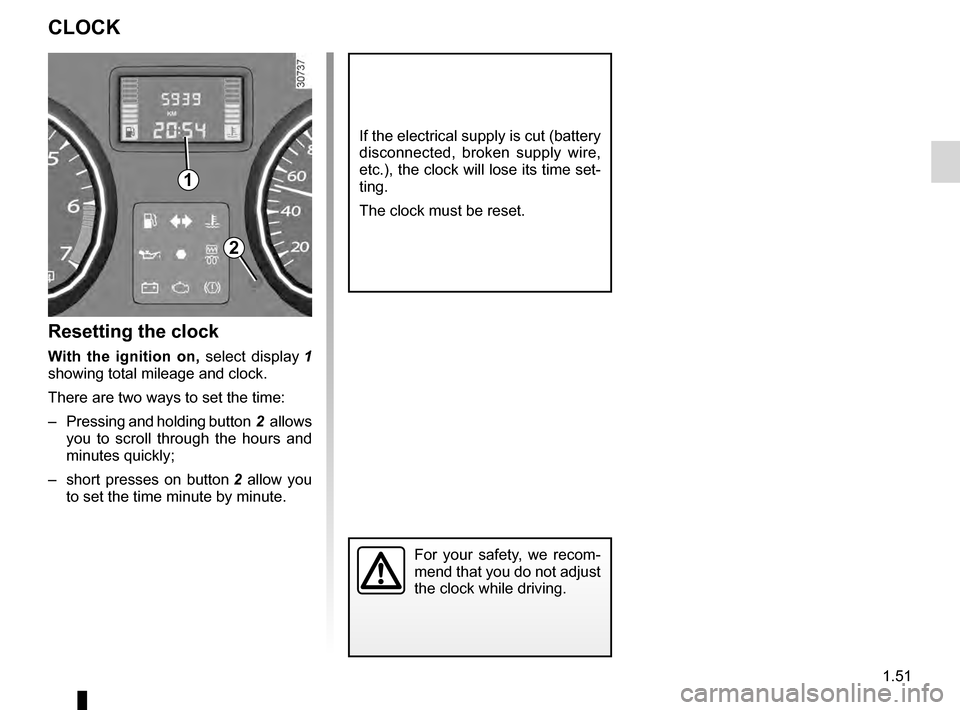
clock ...................................................................... (current page)
clock ...................................................................... (current page)
1.51
ENG_UD20658_3
Tableau de bord: heure (H79 - Dacia)
ENG_NU_898-5_H79_Dacia_1
Clock
CLOCK
Resetting the clock
With the ignition on, select display 1
showing total mileage and clock.
There are two ways to set the time:
–
Pressing
and holding button 2 allows
you to scroll through the hours and
minutes quickly;
–
short
presses on button 2 allow you
to set the time minute by minute.
If the electrical supply is cut (battery
disconnected, broken supply wire,
etc.), the clock will lose its time set-
ting.
The clock must be reset.
For your safety, we recom-
mend that you do not adjust
the clock while driving.
2
1
Page 58 of 200
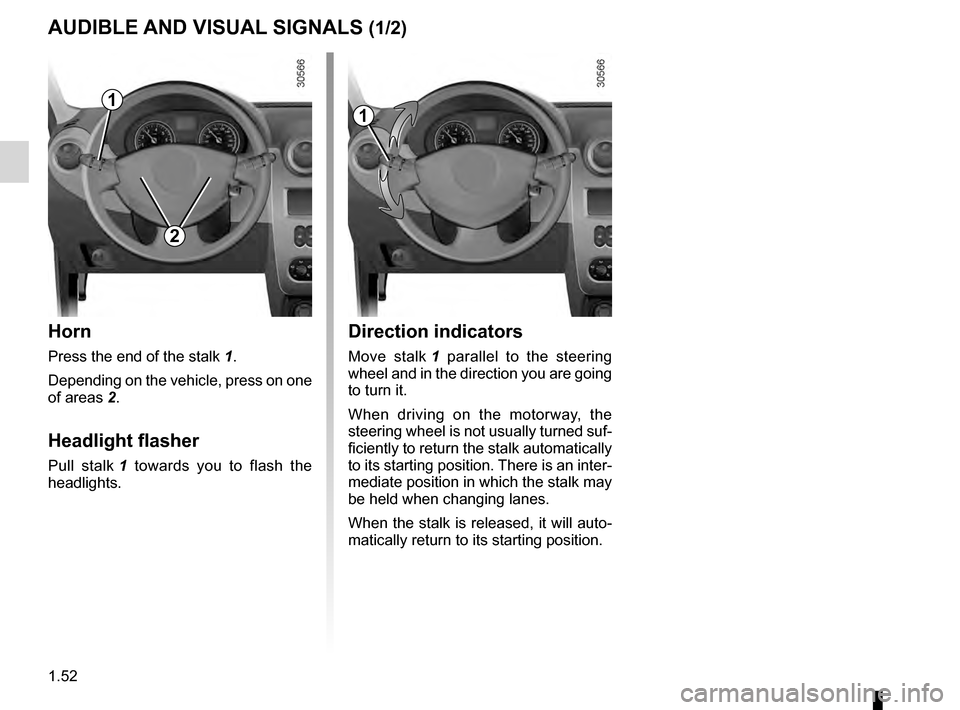
headlight flashers ................................. (up to the end of the DU)
horn ...................................................... (up to the end of the DU)
indicators .............................................. (up to the end of the DU)
lights: direction indicators .......................... (up to the end of the DU)
lights: hazard warning ............................... (up to the end of the DU)
indicators: direction indicators .......................... (up to the end of the DU)
hazard warning lights signal ................. (up to the end of the DU)
hazard warning lights signal ................. (up to the end of the DU)
1.52
ENG_UD24503_3
Avertisseurs sonore et lumineux (H79 - Dacia)
ENG_NU_898-5_H79_Dacia_1
Jaune NoirNoir texte
Audible and visual signals
AUDIBLE AND VISUAL SIGNALS (1/2)
Horn
Press the end of the stalk 1.
Depending on the vehicle, press on one
of areas
2.
Headlight flasher
Pull stalk 1 towards you to flash the
headlights.
1
2
Direction indicators
Move stalk 1 parallel to the steering
wheel and in the direction you are going
to turn it.
When driving on the motorway, the
steering wheel is not usually turned suf-
ficiently to return the stalk automatically
to its starting position. There is an inter-
mediate position in which the stalk may
be held when changing lanes.
When the stalk is released, it will auto-
matically return to its starting position.
1
Page 60 of 200
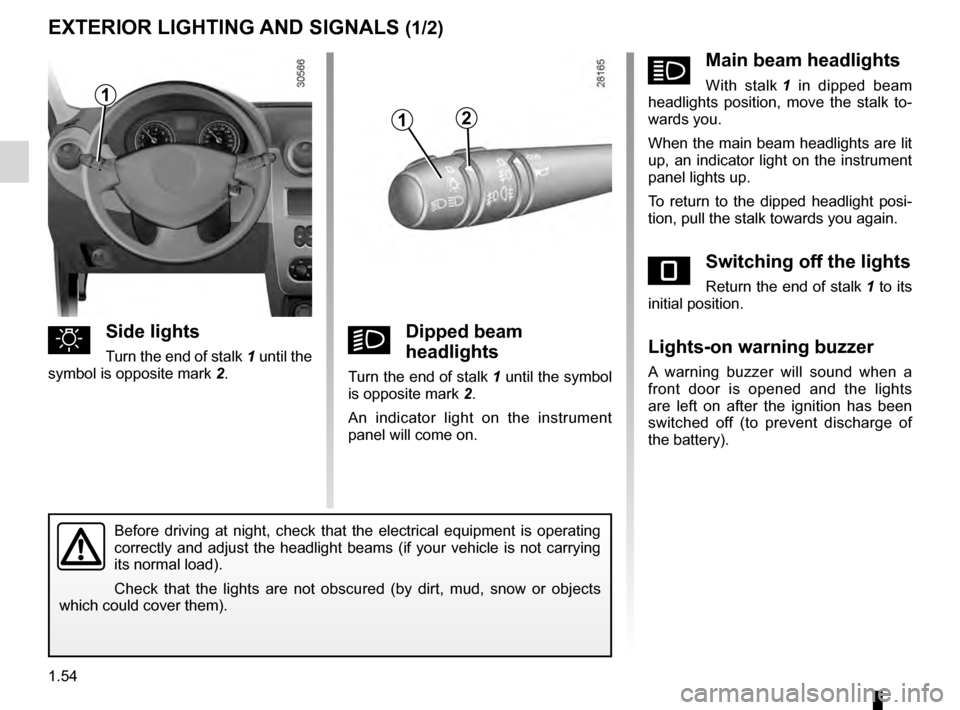
lighting:exterior ............................................ (up to the end of the DU)
lights: dipped beam headlights ................................... (current page)
lights: side lights ......................................................... (current page)
lights: main beam headlights ...................................... (current page)
lights ..................................................... (up to the end of the DU)
signals and lights .................................. (up to the end of the DU)
control instruments ............................... (up to the end of the DU)
1.54
ENG_UD14459_1
Éclairages et signalisations extérieures (H79 - Dacia)
ENG_NU_898-5_H79_Dacia_1
Jaune NoirNoir texte
Exterior lighting and signals
EXTERIOR LIGHTING AND SIGNALS (1/2)
uSide lights
Turn the end of stalk 1 until the
symbol is opposite mark 2 .kDipped beam
headlights
Turn the end of stalk 1 until the symbol
is opposite mark 2 .
An indicator light on the instrument
panel will come on.
áMain beam headlights
With stalk 1 in dipped beam
headlights position, move the stalk to-
wards you.
When the main beam headlights are lit
up, an indicator light on the instrument
panel lights up.
To return to the dipped headlight posi-
tion, pull the stalk towards you again.
eSwitching off the lights
Return the end of stalk 1 to its
initial position.
Lights-on warning buzzer
A warning buzzer will sound when a
front door is opened and the lights
are left on after the ignition has been
switched off (to prevent discharge of
the battery).
Before driving at night, check that the electrical equipment is operating
correctly and adjust the headlight beams (if your vehicle is not carrying
its normal load).
Check that the lights are not obscured (by dirt, mud, snow or objects
which could cover them).
12
1
Page 69 of 200
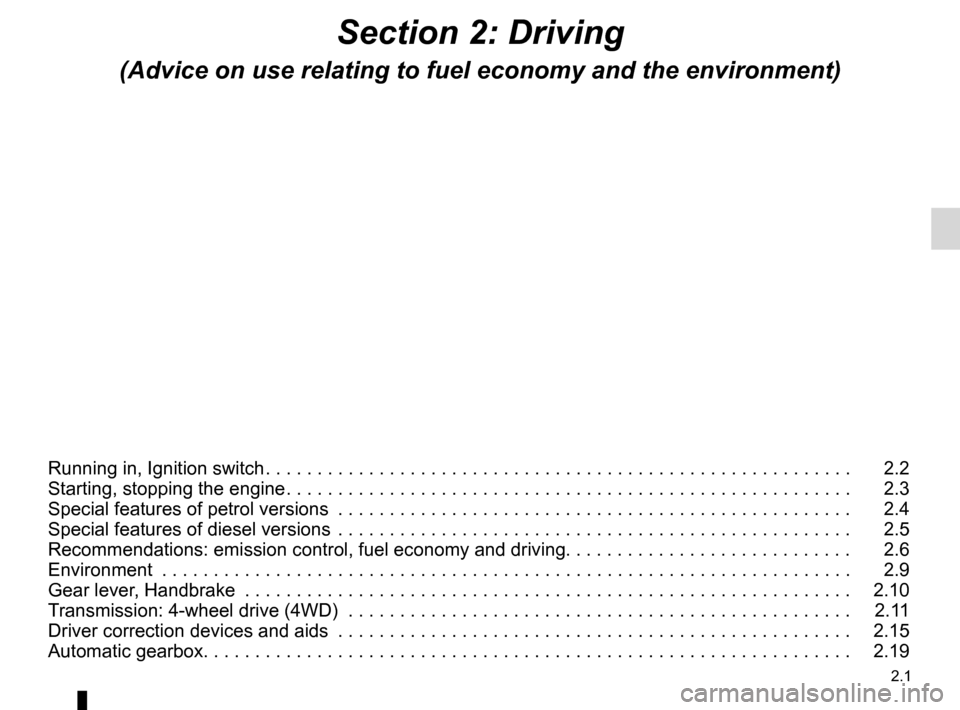
2.1
ENG_UD25061_7
Sommaire 2 (H79 - Dacia)
ENG_NU_898-5_H79_Dacia_2
Section 2: Driving
(Advice on use relating to fuel economy and the environment)
Running in, Ignition switch . . . . . . . . . . . . . . . . . . . . . . . . . . . . . . . . . . . . . . . . . . . . . . . . . . . . . . . . . 2.2
Starting, stopping the engine
. . . . . . . . . . . . . . . . . . . . . . . . . . . . . . . . . . . . . . . . . . . . . . . . . . . . . . .
2.3
Special features of petrol versions
.
. . . . . . . . . . . . . . . . . . . . . . . . . . . . . . . . . . . . . . . . . . . . . . . . .
2.4
Special features of diesel versions
.
. . . . . . . . . . . . . . . . . . . . . . . . . . . . . . . . . . . . . . . . . . . . . . . . .
2.5
Recommendations: emission control, fuel economy and driving. . . . . . . . . . . . . . . . . . . . . . . . . . . .
2.6
Environment
.
. . . . . . . . . . . . . . . . . . . . . . . . . . . . . . . . . . . . . . . . . . . . . . . . . . . . . . . . . . . . . . . . . .
2.9
Gear lever
, Handbrake
.
. . . . . . . . . . . . . . . . . . . . . . . . . . . . . . . . . . . . . . . . . . . . . . . . . . . . . . . . . .
2.10
T
ransmission: 4-wheel drive (4WD)
.
. . . . . . . . . . . . . . . . . . . . . . . . . . . . . . . . . . . . . . . . . . . . . . . .
2.1
1
Driver correction devices and aids
.
. . . . . . . . . . . . . . . . . . . . . . . . . . . . . . . . . . . . . . . . . . . . . . . . .
2.15
Automatic gearbox. . . . . . . . . . . . . . . . . . . . . . . . . . . . . . . . . . . . \
. . . . . . . . . . . . . . . . . . . . . . . . . . .
2.19
Page 70 of 200
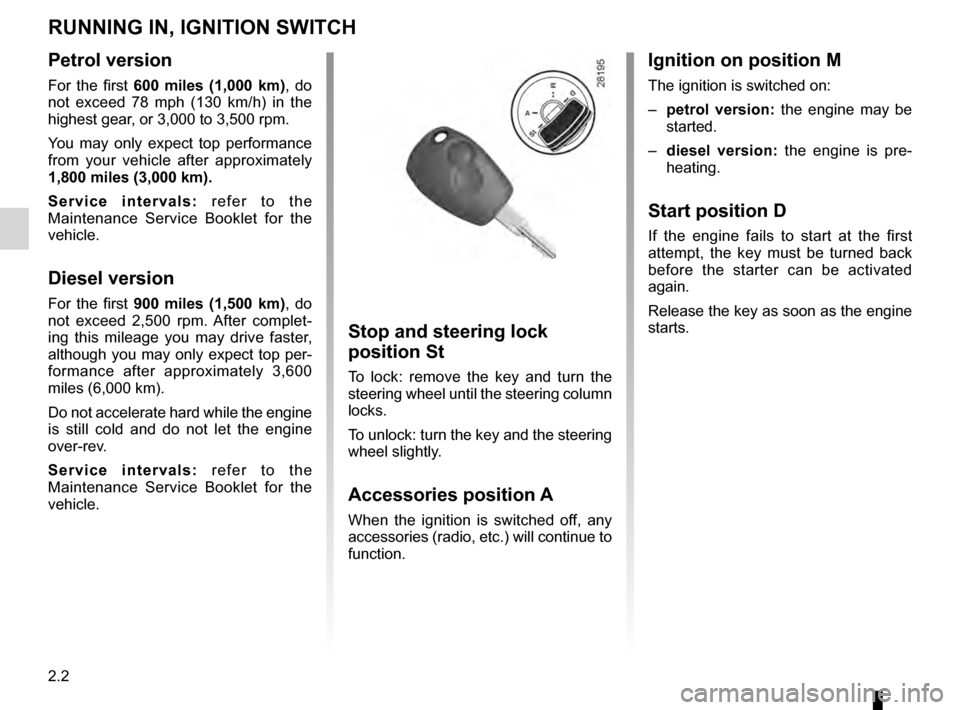
engine immobiliser (switch) .................. (up to the end of the DU)
ignition switch ....................................... (up to the end of the DU)
starting the engine ................................ (up to the end of the DU)
running in .............................................. (up to the end of the DU)
driving ................................................... (up to the end of the DU)
2.2
ENG_UD20629_3
Rodage / Contacteur de démarrage (H79 - Dacia)
ENG_NU_898-5_H79_Dacia_2
Running in, Ignition switch
Petrol version
For the first 600 miles (1,000 km), do
not exceed 78 mph (130 km/h) in the
highest gear, or 3,000 to 3,500 rpm.
You may only expect top performance
from your vehicle after approximately
1,800 miles (3,000 km).
S e r v i c e i n t e r v a l s : r e f e r t o t h e
Maintenance Service Booklet for the
vehicle.
Diesel version
For the first 900 miles (1,500 km), do
not exceed 2,500 rpm. After complet-
ing this mileage you may drive faster,
although you may only expect top per-
formance after approximately 3,600
miles (6,000 km).
Do not accelerate hard while the engine
is still cold and do not let the engine
over-rev.
S e r v i c e i n t e r v a l s : r e f e r t o t h e
Maintenance Service Booklet for the
vehicle.
RUNNING IN, IGNITION SWITCH
Stop and steering lock
position St
To lock: remove the key and turn the
steering wheel until the steering column
locks.
To unlock: turn the key and the steering
wheel slightly.
Accessories position A
When the ignition is switched off, any
accessories (radio, etc.) will continue to
function.
Ignition on position M
The ignition is switched on:
–
p
etrol version: the engine may be
started.
–
d
iesel version: the engine is pre-
heating.
Start position D
If the engine fails to start at the first
attempt, the key must be turned back
before the starter can be activated
again.
Release the key as soon as the engine
starts.
Page 71 of 200
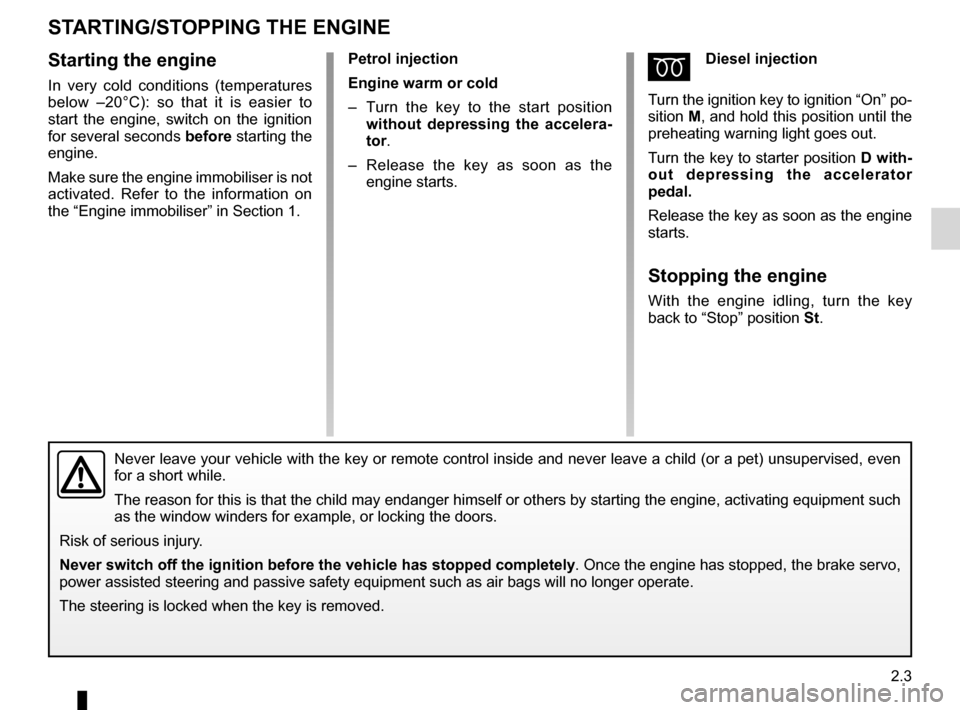
driving ................................................... (up to the end of the DU)
starting .................................................. (up to the end of the DU)
starting the engine ................................ (up to the end of the DU)
2.3
ENG_UD17439_2
Mise en route / Arrêt du moteur (H79 - Dacia)
ENG_NU_898-5_H79_Dacia_2
Petrol injection
Engine warm or cold
–
T
urn the key to the start position
without depressing the accelera-
tor.
–
R
elease the key as soon as the
engine starts.ÉDiesel injection
T
urn the ignition key to ignition “On” po-
sition M, and hold this position until the
preheating warning light goes out.
Turn the key to starter position D with-
out depressing the accelerator
pedal.
Release the key as soon as the engine
starts.
Stopping the engine
With the engine idling, turn the key
back to “Stop” position St.
Starting the engine
In very cold conditions (temperatures
below –20°C): so that it is easier to
start the engine, switch on the ignition
for several seconds before starting the
engine.
Make sure the engine immobiliser is not
activated. Refer to the information on
the “Engine immobiliser” in Section 1.
Starting/stopping the engine
STARTING/STOPPING THE ENGINE
Never leave your vehicle with the key or remote control inside and never leave a child (or a pet) unsupervised, even
for a short while.
The reason for this is that the child may endanger himself or others by starting the engine, activating equipment such
as the window winders for example, or locking the doors.
Risk of serious injury.
Never switch off the ignition before the vehicle has stopped completely. Once the engine has stopped, the brake servo,
power assisted steering and passive safety equipment such as air bags wi\
ll no longer operate.
The steering is locked when the key is removed.
Page 72 of 200
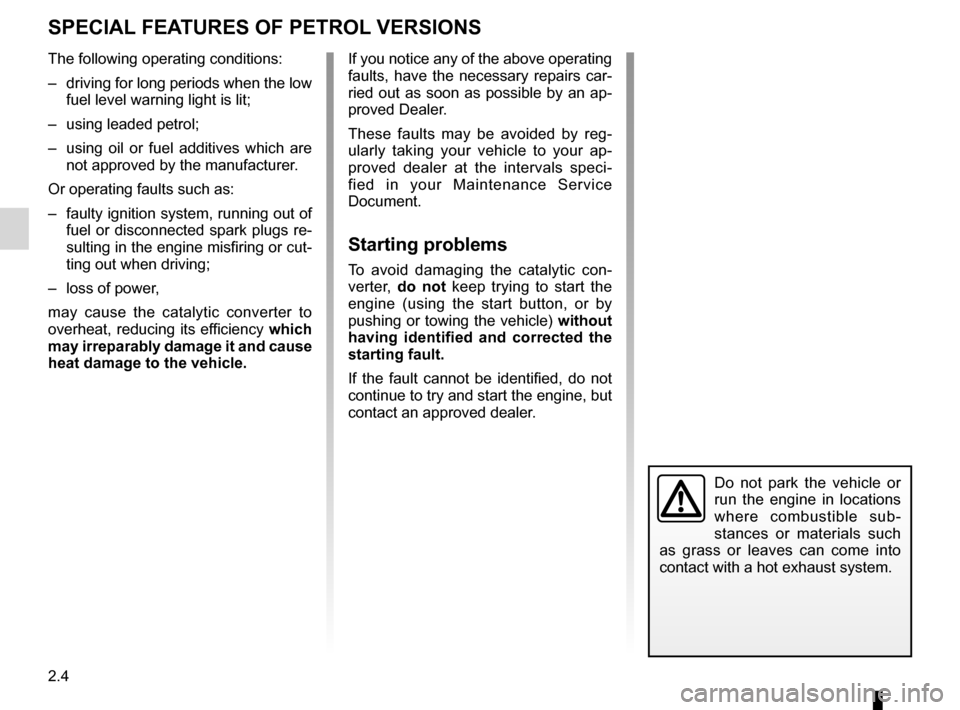
driving ................................................... (up to the end of the DU)
catalytic converter................................. (up to the end of the DU)
catalytic converter................................. (up to the end of the DU)
special features of petrol vehicles ........ (up to the end of the DU)
2.4
ENG_UD18237_9
Particularités des versions essence (B90 - U90 - L90 Ph2 - F90 Ph2 -\
R90 Ph2 - H79 - Dacia)
ENG_NU_898-5_H79_Dacia_2
Special features of petrol versions
SPECIAL FEATURES OF PETROL VERSIONS
The following operating conditions:
–
driving
for long periods when the low
fuel level warning light is lit;
–
using leaded petrol;
–
u
sing oil or fuel additives which are
not approved by the manufacturer.
Or operating faults such as:
–
faulty
ignition system, running out of
fuel or disconnected spark plugs re-
sulting in the engine misfiring or cut-
ting out when driving;
–
loss of power
,
may cause the catalytic converter to
overheat, reducing its efficiency which
may irreparably damage it and cause
heat damage to the vehicle. If you notice any of the above operating
faults, have the necessary repairs car-
ried out as soon as possible by an ap-
proved Dealer.
These faults may be avoided by reg-
ularly taking your vehicle to your ap-
proved dealer at the intervals speci-
fied in your Maintenance Service
Document.
Starting problems
To avoid damaging the catalytic con-
verter,
do not keep trying to start the
engine (using the start button, or by
pushing or towing the vehicle) without
having identified and corrected the
starting fault.
If the fault cannot be identified, do not
continue to try and start the engine, but
contact an approved dealer.
Do not park the vehicle or
run the engine in locations
where combustible sub-
stances or materials such
as grass or leaves can come into
contact with a hot exhaust system.
Page 73 of 200
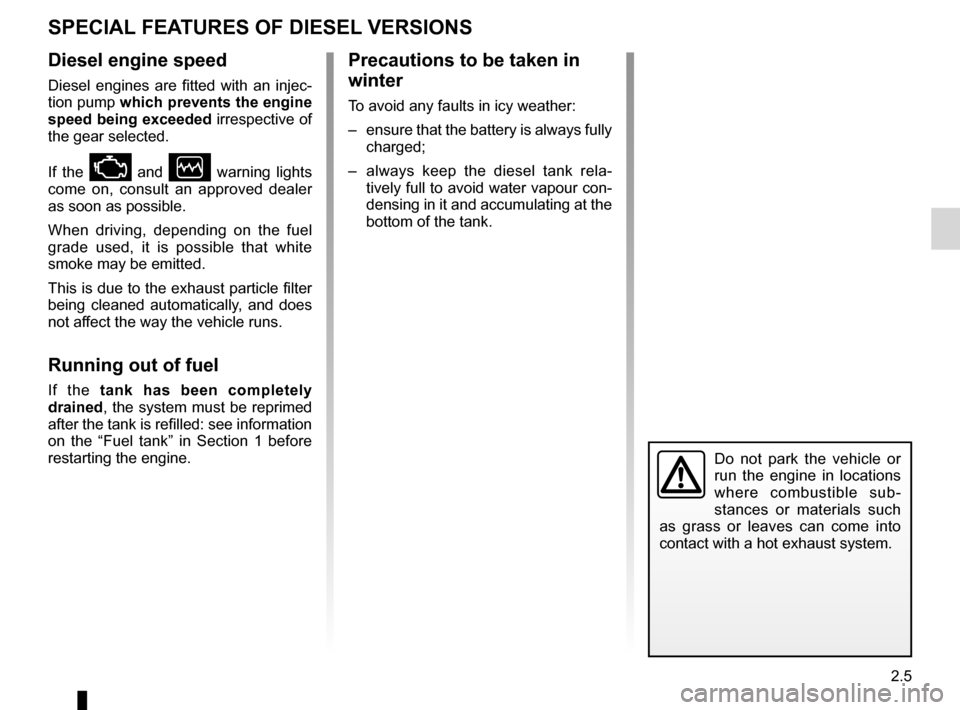
driving ................................................... (up to the end of the DU)
special features of diesel versions........ (up to the end of the DU)
2.5
ENG_UD14105_1
Particularités des versions diesel (H79 - Dacia)
ENG_NU_898-5_H79_Dacia_2
Special features of diesel versions
SPECIAL FEATURES OF DIESEL VERSIONS
Diesel engine speed
Diesel engines are fitted with an injec-
tion pump which prevents the engine
speed being exceeded irrespective of
the gear selected.
If the
Ä and Ò warning lights
come on, consult an approved dealer
as soon as possible.
When driving, depending on the fuel
grade used, it is possible that white
smoke may be emitted.
This is due to the exhaust particle filter
being cleaned automatically, and does
not affect the way the vehicle runs.
Running out of fuel
If the tank has been completely
drained, the system must be reprimed
after the tank is refilled: see information
on the “Fuel tank” in Section 1 before
restarting the engine.
Precautions to be taken in
winter
To avoid any faults in icy weather:
–
ensure
that the battery is always fully
charged;
–
a
lways keep the diesel tank rela-
tively full to avoid water vapour con-
densing in it and accumulating at the
bottom of the tank.
Do not park the vehicle or
run the engine in locations
where combustible sub-
stances or materials such
as grass or leaves can come into
contact with a hot exhaust system.
Page 74 of 200
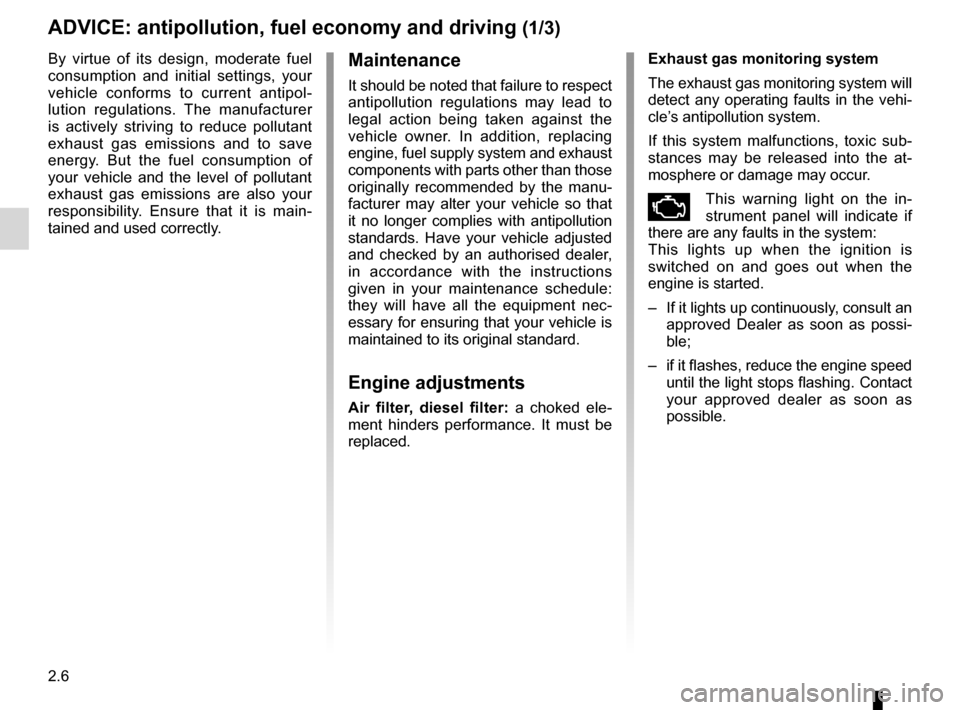
antipollutionadvice ............................................. (up to the end of the DU)
fuel advice on fuel economy .................. (up to the end of the DU)
driving ................................................... (up to the end of the DU)
fuel economy ........................................ (up to the end of the DU)
2.6
ENG_UD22435_3
Conseils : antipollution, économies de carburant, conduite (H79 - Da\
cia)
ENG_NU_898-5_H79_Dacia_2
Jaune NoirNoir texte
Advice: antipollution, fuel economy and driving
By virtue of its design, moderate fuel
consumption and initial settings, your
vehicle conforms to current antipol-
lution regulations. The manufacturer
is actively striving to reduce pollutant
exhaust gas emissions and to save
energy. But the fuel consumption of
your vehicle and the level of pollutant
exhaust gas emissions are also your
responsibility. Ensure that it is main-
tained and used correctly.Maintenance
It should be noted that failure to respect
antipollution regulations may lead to
legal action being taken against the
vehicle owner. In addition, replacing
engine, fuel supply system and exhaust
components with parts other than those
originally recommended by the manu-
facturer may alter your vehicle so that
it no longer complies with antipollution
standards. Have your vehicle adjusted
and checked by an authorised dealer,
in accordance with the instructions
given in your maintenance schedule:
they will have all the equipment nec-
essary for ensuring that your vehicle is
maintained to its original standard.
Engine adjustments
Air filter, diesel filter: a choked ele-
ment hinders performance. It must be
replaced. Exhaust gas monitoring system
The exhaust gas monitoring system will
detect any operating faults in the vehi-
cle’s antipollution system.
If this system malfunctions, toxic sub-
stances may be released into the at-
mosphere or damage may occur.
ÄThis warning light on the in-
strument panel will indicate if
there are any faults in the system:
This lights up when the ignition is
switched on and goes out when the
engine is started.
–
If
it lights up continuously, consult an
approved Dealer as soon as possi-
ble;
–
if
it flashes, reduce the engine speed
until the light stops flashing. Contact
your approved dealer as soon as
possible.
ADVICE: antipollution, fuel economy and driving (1/3)
Page 75 of 200
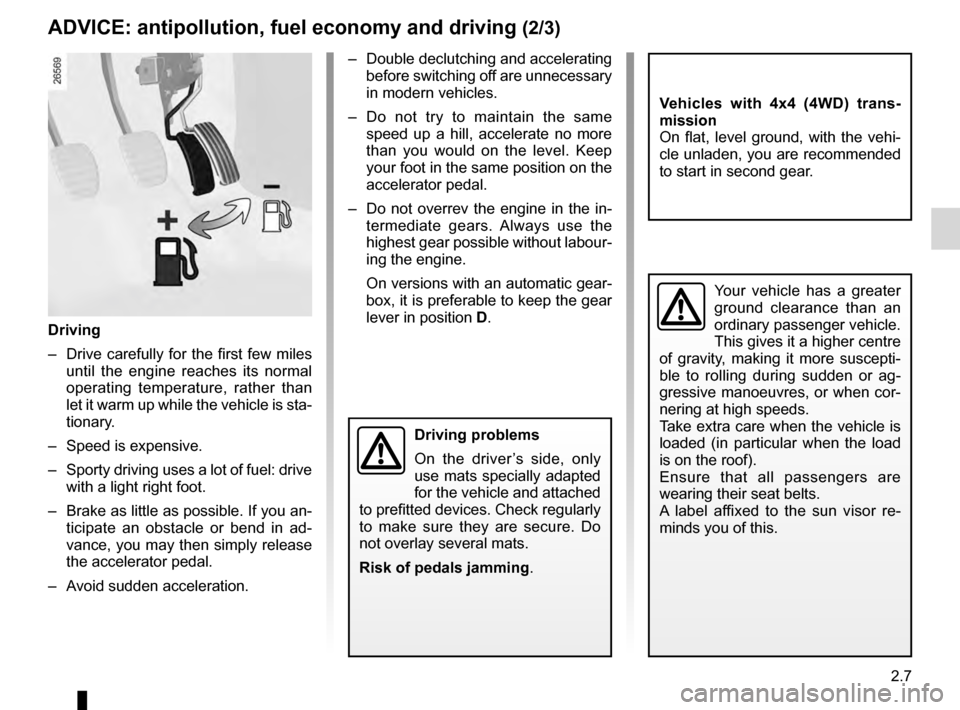
JauneNoirNoir texte
2.7
ENG_UD22435_3
Conseils : antipollution, économies de carburant, conduite (H79 - Da\
cia)
ENG_NU_898-5_H79_Dacia_2
Driving
–
Drive
carefully for the first few miles
until the engine reaches its normal
operating temperature, rather than
let it warm up while the vehicle is sta-
tionary.
–
Speed
is expensive.
–
Sporty
driving uses a lot of fuel: drive
with a light right foot.
–
Brake
as little as possible. If you an-
ticipate an obstacle or bend in ad-
vance, you may then simply release
the accelerator pedal.
–
A
void sudden acceleration.
ADVICE: antipollution, fuel economy and driving (2/3)
– Double declutching and accelerating before switching off are unnecessary
in modern vehicles.
–
D
o not try to maintain the same
speed up a hill, accelerate no more
than you would on the level. Keep
your foot in the same position on the
accelerator pedal.
–
Do
not overrev the engine in the in-
termediate gears. Always use the
highest gear possible without labour-
ing the engine.
On versions with an automatic gear-
box, it is preferable to keep the gear
lever in position D.
Your vehicle has a greater
ground clearance than an
ordinary passenger vehicle.
This gives it a higher centre
of gravity, making it more suscepti-
ble to rolling during sudden or ag-
gressive manoeuvres, or when cor-
nering at high speeds.
Take extra care when the vehicle is
loaded (in particular when the load
is on the roof).
Ensure that all passengers are
wearing their seat belts.
A label affixed to the sun visor re-
minds you of this.
Vehicles with 4x4 (4WD) trans-
mission
On flat, level ground, with the vehi-
cle unladen, you are recommended
to start in second gear.
Driving problems
On the driver ’s side, only
use mats specially adapted
for the vehicle and attached
to prefitted devices. Check regularly
to make sure they are secure. Do
not overlay several mats.
Risk of pedals jamming .